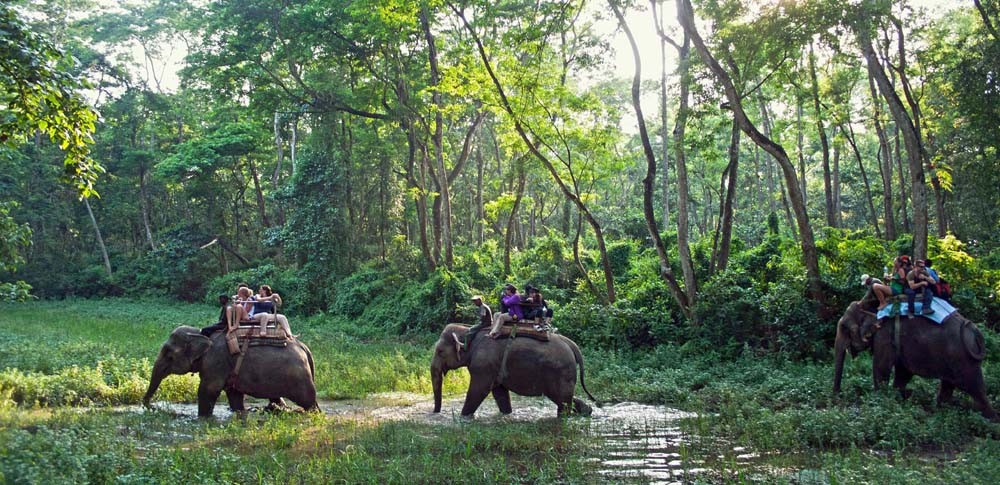Subscribe Our E-Newsletter
Sign up for Best Deals and Discount. Get News, Notifications and Updates
Chitwan National Park Tour

Chitwan National Park is the first and famous national park in Nepal. Is situated in the Inner Terai Lowlands of Chitwan. It was established in 1973 and declared the status of a World Heritage Site in 1984 by UNESCO. It covers an area of 932 km2 and is located in the subtropical Inner Terai lowlands of south-central Nepal in the Chitwan District. In altitude it ranges from about 100 m in the river valleys to 815 m in the Churia Hills.
Chitwan National Park is shelter to the last endangered Asian species like the one-horned rhinoceros and the Royal Bengal tiger. Other animals found here are the leopard, sloth bear, wild boar, rhesus monkey, grey langur monkey, wild dog, small wild cats, bison, the four species of deer and other small animals. Chitwan National Park is also home to 450 species of bird and hence is ideal for bird watching. In summer the forest is alive with nesting migrants such as the fabulous paradise flycatcher, the Indian pitta and parakeets.
In addition to these there are number of Jungle safari excursions like Canoe ride, Chitwan Tharu Cultural Show, Chitwan Tharu Village Tour, Sunset Viewing and Bicyle Tour to Chitwan Elephant Breeding Centre.
Climate
The Park has a range of climatic seasons each offering a unique experience. October through February with average temperatures of 25oc offer an enjoyable climate. From March to June temperatures can reach as high as 43oC. The hot humid days give way to the monsoon season that typically lasts from late June until September, rivers become flooded and roads are impossible.
In late January, local villagers are allowed to cut thatch grasses to meet their needs, which offer a better viewing of wildlife for visitors. Also, between September and November and February and April, migratory birds join the residential birds and create spectacular bird watching opportunities. While the monsoon rains bring lush vegetation, most trees flower in late winter. The palash tree, known as the “flame of the forest’ and silk cotton tree have spectacular crimson flowers that can be seen from a distance.
The Chitwan National Park has a tropical monsoon climate, with height humidity all through the year, and three main seasons.
Summer
March to early June are the traditional hot months, with temperatures rising progressively to a peak in May. During April, despite the heat of the day the nights can be quite cold. South – westerly winds prevail, and relative humidity is lowest in March.
Monsoon
Towards the end of May the pre-monsoon storms set in. Dark clouds mass in the afternoons, with thunder and lightning and high winds. If rain falls, it comes in late afternoon showers lasting perhaps only fifteen to twenty minutes. As May changes into June the showers come with increasing frequency.
When the monsoon proper begins, around the middle of June, it is another story. From then until late September the moisture-laden south-easterly winds weeping up from the Bay of Bengal bring heavy rain, and of the annual total of some 80 inches, more than 80 per cent falls in these three months.
Precipitation is not normally continuous, and often, in any monsoon month, there are as many dry days as wet ones. During the monsoon humidity is extremely high.
Winter
Winter lasts from October to the end of February. The northerly winds are cool, coming down from the mountains, and this is the best time of the year to see the Great Himalayan Range, the air being particularly clear in November.
January is the coldest month, with temperatures falling almost to freezing-point, especially when it rains. From late November the relative humidity touches 100 percent in the mornings, and so there is dewfall during December and January nights and sometimes when you hear the drips pouring off the trees in the morning, it is often mistaken for rain. After an especially cold morning it is hard to believe that the temperature will rise to 20-25 Celsius in the afternoon.
Another activity in the park is the boat/canoe trip down the Rapti and the Narayani Rivers. This is one of the more serene ways to explore the area as float downstream with the river’s flow. On the out skirts of Chitwan you can the Tharu community, and see their artistically decorated thatched huts, their typical dance and how they manage life next to the national park. A Chitwan jungle safari is certainly an adventure that the whole family can enjoy. Here is some activities for Chitwan National Park Trip Packages, We Himalaya Trekking Team always provide excellent services to our clients.
Sign up for Best Deals and Discount. Get News, Notifications and Updates
Copyright © 2013 - 2025. https://www.himalayatrekkingteam.com All Rights Reserved. Developed By: Xenatech Nepal.